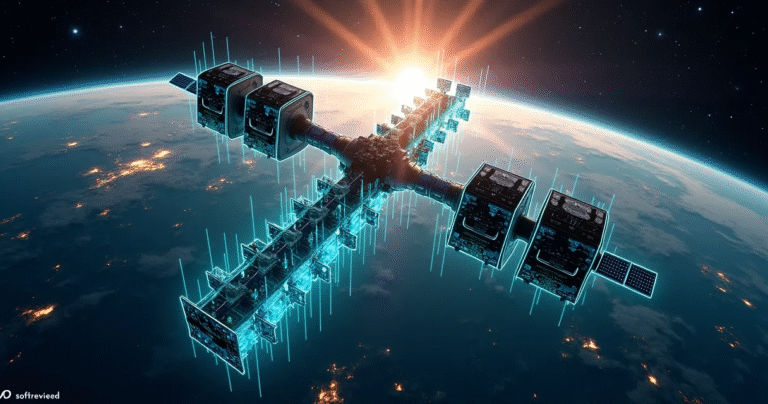China’s Three-Body Space AI Constellation
An ambitious space-based artificial intelligence network that’s revolutionizing computing beyond Earth’s atmosphere
Massive Scale
The “Three-Body Computing Constellation” plans to deploy 2,800 satellites in Earth orbit, with 12 already successfully launched. This unprecedented network will create a distributed computing platform spanning the globe from space.
AI Powerhouse
Each satellite houses sophisticated AI systems capable of running 8 billion-parameter models and processing an astounding 1 quintillion operations per second. This creates a space-based supercomputing network with capabilities rivaling Earth’s most powerful systems.
Space-Based Efficiency
The constellation leverages the natural vacuum of space for cooling, eliminating the massive energy costs associated with terrestrial data centers. By processing data directly in orbit, the system bypasses traditional infrastructure limitations and cooling challenges.
Applications
The network enables breakthrough applications including gamma-ray burst detection and comprehensive “digital twin” Earth terrain mapping. These capabilities provide critical support for emergency services, disaster response, and scientific research with unprecedented speed and accuracy.
High-Speed Laser Links
The satellites communicate via advanced laser technology supporting 100 Gbps inter-satellite links. This creates a high-bandwidth mesh network in space, enabling seamless data transfer and distributed computing across the entire constellation.
What Exactly is This "Three-Body Computing Constellation"? 🤔
Imagine a network of interconnected computers, not in a sprawling data center on Earth, but orbiting our planet. That's the core idea behind the Three-Body Computing Constellation. Spearheaded by the Chinese company ADA Space and Zhejiang Lab, this initiative aims to create a distributed AI supercomputer in space.
The project recently saw its first major deployment. On May 14, 2025, a Long March 2D rocket lifted off from China's Jiuquan Satellite Launch Center, carrying the first 12 satellites. These aren't just passive communication relays; they are active processing units. The ultimate vision is a constellation of 2,800 such satellites, working in concert.
The Tech Powering the Celestial Processors 💡
Each of these initial 12 satellites is a technological marvel in its own right. According to an ADA Space statement, each satellite houses an 8 billion-parameter AI model. This allows it to perform a staggering 744 tera operations per second (TOPS). To put that into perspective, Microsoft's latest AI Copilot+ laptops are rated around 40 TOPS.
When the processing power of these 12 satellites is combined, they can achieve approximately five peta operations per second (POPS). The full constellation, once complete, is projected to deliver a mind-boggling 1,000 POPS (or one quintillion operations per second). This would rival, and potentially exceed, the capabilities of some of the most powerful terrestrial supercomputers.
Key technological features include:
- 📌 In-Orbit AI Models: Each satellite can process raw data directly in space, reducing the need to transmit vast amounts of data back to Earth.
- 📌 High-Speed Laser Communication: The satellites are interconnected via laser links, enabling data transfer at up to 100 gigabits per second between them.
- 📌 Onboard Storage: The initial cluster boasts 30 terabytes of onboard storage.
Why Take Supercomputing to Space? The Sky-High Advantages 🌌
You might be wondering, "Why go through the immense effort and expense of putting supercomputers in space?" There are several compelling reasons:
- ✅ Reduced Latency: For tasks involving satellite-generated data (like Earth observation or space-based sensors), processing data directly in orbit significantly cuts down the time it takes to get actionable insights. Traditionally, raw data is beamed to Earth, processed, and then the results might be sent back up. This orbital approach streamlines that entire workflow.
- ✅ Energy Efficiency & Cooling: Terrestrial data centers are notoriously power-hungry and require massive cooling systems, often using vast amounts of water. In space, satellites can harness abundant solar power. Moreover, the cold vacuum of space provides a natural, and free, cooling system, radiating waste heat away. This could drastically reduce the carbon footprint associated with large-scale computing.
- ✅ Overcoming Bandwidth Bottlenecks: Transmitting raw data from satellites to Earth is often constrained by limited bandwidth and transmission windows. ADA Space notes that often less than 10% of raw satellite data makes it to Earth due to these limitations. By processing data at the source, only the valuable, processed information needs to be sent, optimizing bandwidth usage.
- ✅ Global Coverage & Accessibility: A satellite constellation can provide consistent data processing capabilities across the globe, unhindered by terrestrial infrastructure limitations or geographical boundaries.
As Wang Jian, director of Zhejiang Lab, stated at the Beyond Expo tech conference, "It's a good time to think about how we can put AI into space, not just in your laptop or cellphone. Space has, again, become the frontier for us to think about what we can do in the next 10, 20 or 50 years."
From Earth-Bound Limits to Orbital Opportunities: The Genesis of an Idea
The concept of computing in space isn't entirely new, but China's "Three-Body Computing Constellation" represents the most ambitious and large-scale attempt to realize it. This project didn't materialize overnight; it's built upon years of advancements in satellite technology, AI, and rocketry.
The Historical Context: A Gradual Ascent 📈
For decades, satellites have been collecting data, but their role was primarily as sensors and communication relays. The processing happened on the ground. However, with the miniaturization of computing components, the rise of powerful AI algorithms, and decreasing launch costs, the idea of moving processing power closer to the data source – i.e., into orbit – has become increasingly feasible.
China has been steadily advancing its space capabilities, including the Tiandu-1 and Tiandu-2 satellites, launched in March 2024. These experimental satellites, part of the Queqiao-2 mission, are designed to test technologies for a lunar navigation and communication network. While distinct from the AI supercomputer constellation, projects like Tiandu demonstrate China's growing expertise in complex satellite operations and inter-satellite communication, which are crucial for the "Three-Body" project. You can learn more about these precursor missions from sources like Wikipedia's page on Tiandu satellites.
Connecting the Dots: How it Fits the Bigger AI Picture 🖼️
This space-based AI initiative aligns with China's broader strategic goals of becoming a global leader in artificial intelligence by 2030. By developing an independent, cutting-edge AI infrastructure in orbit, China aims to:
- ➡️ Reduce reliance on foreign technology and ground-based computing infrastructure.
- ➡️ Gain a strategic advantage in areas like Earth observation, climate modeling, and potentially defense applications.
- ➡️ Foster innovation in AI applications tailored for space environments.
Researchers from Xihai Shudao Data Technology, in a paper published in Chinese Space Science and Technology, proposed a "Space Computing Project" aiming to use space-based solar power to process satellite data in orbit. This further underscores the strategic thinking behind such initiatives.
The Potential Game-Changers: What This Orbital AI Could Do 💡
The applications for a powerful, responsive AI supercomputer network in space are vast and potentially transformative.
Real-Time Earth Observation and Disaster Response 🌍
Imagine satellites not just capturing images of a developing hurricane or a wildfire, but analyzing that data in real-time, identifying critical changes, and relaying actionable intelligence directly to emergency responders on the ground within minutes. This could revolutionize disaster management by:
- 📌 Providing faster and more accurate damage assessments.
- 📌 Optimizing evacuation routes.
- 📌 Directing rescue efforts more efficiently.
- 📌 Monitoring environmental changes like deforestation or ice melt with unprecedented detail and speed.
Advancing Scientific Discovery 🔬
From astronomy to climate science, the ability to process massive datasets in orbit opens new avenues for research:
- 📌 Astronomy: Analyzing data from space telescopes in real-time to detect transient astronomical events like gamma-ray bursts or supernovae. One of the newly launched satellites even carries a cosmic X-ray polarimeter for this purpose, in collaboration with Guangxi University and the National Astronomical Observatories of the Chinese Academy of Sciences.
- 📌 Climate Modeling: Improving the accuracy and timeliness of climate models by continuously processing vast streams of atmospheric and oceanic data.
- 📌 Materials Science in Space: AI could assist in experiments conducted in the unique microgravity environment of space, accelerating the discovery of new materials.
Fueling Future Space Exploration 🚀
As humanity looks towards more ambitious space missions, including potential bases on the Moon or Mars, robust in-space computing will be essential:
- 📌 Autonomous Navigation: AI-powered systems can enable spacecraft to navigate complex orbital environments or during deep-space journeys with greater autonomy.
- 📌 Robotics and In-Situ Resource Utilization (ISRU): Managing and coordinating robotic systems for construction, resource extraction, or scientific experiments on other celestial bodies.
- 📌 Crew Support: Providing AI assistance to astronauts, from monitoring life support systems to analyzing mission data.
Voices from the Ground: Expert Perspectives on Celestial AI

The launch of China's AI satellite constellation has, unsurprisingly, sparked considerable discussion among experts and industry observers.
Enthusiasm and Strategic Importance 👍
Many see this as a significant technological leap. Subimal Bhattacharjee, a defense and cybersecurity expert, told FE (Financial Express) that "China’s launch of those 12 satellites for a space-based supercomputing network is a game-changer… This three-body computing constellation with its AI-powered, real-time data crunching in orbit could outpace Earth’s top supercomputers."
Jonathan McDowell, a Harvard astronomer, commented to the South China Morning Post (SCMP) that while the concept of orbital computing isn't new, this project is "the first substantial flight test" of the gambit on this scale.
Cautionary Notes and Technical Hurdles 🤔
However, experts also point to significant challenges. The SCMP article highlights that this is just the "first step in a marathon with many technical hurdles – from radiation-proof hardware to perfecting in-orbit collaboration."
Other concerns include:
- ⛔️ Space Debris: Adding thousands more satellites to already crowded orbits raises concerns about space debris and the potential for collisions.
- ⛔️ Cybersecurity: An orbital supercomputer network could become a high-value target for cyberattacks, with significant implications if compromised. Bhattacharjee noted, "it also raises cybersecurity red flags, like surveillance risks.”
- ⛔️ Dual-Use Potential: The technology, while having many civilian applications, could also be used for military purposes, potentially escalating a space arms race.
Former Google CEO Eric Schmidt, who has invested in space launch company Relativity Space, has also proposed launching data centers into orbit, indicating a growing interest in this domain from various players, not just nation-states.
The Cosmic Calculus: Weighing Benefits Against Challenges
Like any groundbreaking technology, space-based AI supercomputers present a mix of incredible opportunities and significant hurdles.
The Upside: Speed, Efficiency, and Sustainability ☀️
| Benefit | Description |
|---|---|
| Speed & Responsiveness | Real-time data processing in orbit significantly reduces latency for critical applications. |
| Energy Efficiency | Utilizes solar power and the vacuum of space for cooling, potentially lowering carbon footprint. |
| Bandwidth Optimization | Processes raw data in situ, transmitting only valuable insights, easing data downlink bottlenecks. |
| Global Accessibility | Provides consistent processing capabilities worldwide, independent of terrestrial infrastructure. |
| Scalability | Constellation architecture allows for incremental expansion and upgrades of computing power. |
The Downside: Debris, Security, and Cost 💸
| Challenge | Description |
|---|---|
| Space Debris | Adding thousands of satellites increases collision risk and exacerbates the space debris problem. |
| Cybersecurity Risks | Orbital networks could be vulnerable to cyber threats, with potentially severe consequences. |
| High Initial Cost | Designing, building, launching, and maintaining such a constellation involves substantial financial investment. |
| Technical Complexity | Ensuring reliable operation, inter-satellite communication, and radiation hardening in space is challenging. |
| Geopolitical Concerns | Potential for military applications and an escalation of technological competition in space. |
Comparing Apples and Orbits: Space vs. Terrestrial Supercomputing
| Feature | Terrestrial Supercomputers | Space-Based AI Supercomputers (Projected) |
|---|---|---|
| Primary Location | Ground-based data centers | Orbiting satellite constellation |
| Power Source | Electrical grid (often fossil fuel-based) | Solar power |
| Cooling | Energy-intensive HVAC systems, often using water | Passive radiation into the vacuum of space |
| Data Proximity | Data often needs to be transmitted to the center for processing | Processing occurs at or near the source of data (in space) |
| Latency | Can be high for satellite-derived data | Significantly lower for in-orbit processing |
| Scalability | Physical expansion can be complex and costly | Adding more satellites to the constellation |
| Environmental Impact | High energy consumption, carbon footprint, water usage | Potentially lower carbon footprint, no water usage for cooling |
| Accessibility | Dependent on terrestrial networks and infrastructure | Potentially global, direct access from space assets |
Charting the Cosmos: What's Next for In-Orbit AI?
The launch of the first 12 satellites is just the beginning for the "Three-Body Computing Constellation." The roadmap ahead is ambitious.
Expanding the Constellation 🌌
The immediate next step is to continue launching more satellites to build out the planned 2,800-unit network. This will be a phased process, likely involving ongoing testing and refinement of the technology based on the performance of the initial cluster. As more satellites join the network, its overall computing capacity and resilience will grow.
Integrating with Other Technologies 🛰️🔗📡
We can expect to see increasing integration of this space-based AI with other emerging technologies:
- ➡️ Edge Computing in Space: Each satellite effectively acts as an edge computing node, bringing AI processing closer to where data is generated.
- ➡️ Internet of Things (IoT) from Space: The constellation could serve as a powerful backbone for managing and analyzing data from a vast network of space-based sensors.
- ➡️ Advanced Robotics: Controlling and coordinating autonomous robotic systems for in-orbit servicing, assembly, and manufacturing, or for planetary exploration.
Wang Jian of Zhejiang Lab has emphasized that the platform is open to international use, encouraging global participation. This could lead to collaborations and new applications we haven't even conceived of yet.
Beyond the Horizon: The Broader Implications of AI in Space
The development of AI supercomputers in space carries implications that extend far beyond just faster data processing.
A New Arena for Geopolitical Tech Competition? 🌏ፉ🌏
The "Three-Body Computing Constellation" undeniably positions China as a leading player in this nascent field. This could spur other nations and private entities to accelerate their own efforts in space-based computing, potentially leading to a new dimension of technological competition. The strategic advantages offered by such capabilities – in intelligence gathering, resource management, and scientific leadership – are too significant to ignore.
While the European Union and US firms have explored similar concepts, China's deployment of an interconnected 12-satellite system puts them at an operational scale that is currently unmatched.
Ethical Frontiers in the Final Frontier 📜
As with AI on Earth, deploying powerful AI systems in space raises ethical questions:
- 📌 Data Privacy and Sovereignty: Who owns the data processed in space, especially if it's collected over multiple countries?
- 📌 Bias in AI Models: If the AI models used in space carry biases, it could lead to flawed interpretations or unfair outcomes, particularly in Earth observation applications.
- 📌 Autonomous Decision-Making: As these AI systems become more sophisticated, what level of autonomy should they have, especially in scenarios with security implications?
- 📌 Weaponization of Space AI: The potential for misuse in military or surveillance contexts needs careful consideration and international dialogue.
Wrapping Our Heads Around AI in the Heavens ✨
China's launch of the first elements of its "Three-Body Computing Constellation" is a landmark event. It signals a bold move towards a future where significant computational power resides not on Earth, but among the stars. This AI supercomputer in space promises to accelerate scientific discovery, revolutionize industries like disaster response and environmental monitoring, and support humanity's expansion into the cosmos.
However, this giant leap also brings challenges related to cost, technical complexity, space debris, and the geopolitical and ethical dimensions of placing such powerful AI capabilities in orbit. As this celestial network grows, it will undoubtedly reshape our relationship with both artificial intelligence and the final frontier. The journey to a fully operational space-based AI supercomputer is just beginning, and the world will be watching closely to see how this ambitious vision unfolds. What do you think will be the most significant impact of computing among the stars?







